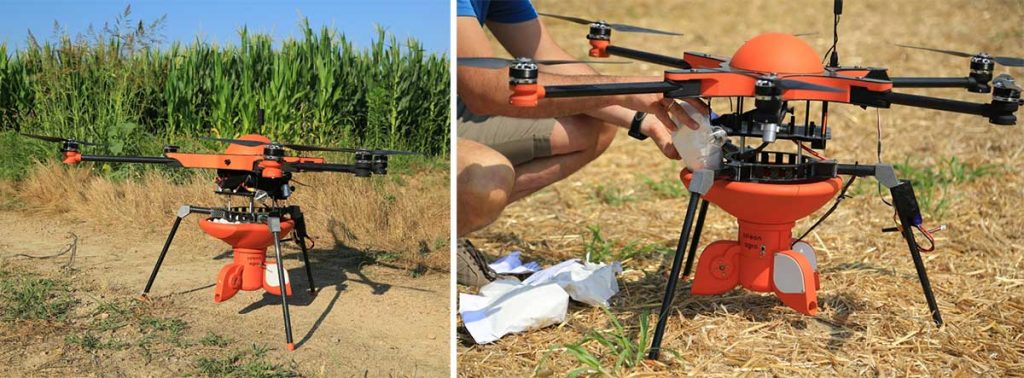 The corn borer is a pest that attacks maize stalks, causing the loss of thousands of crops every year. Rather than drenching said crops with chemicals, a company called Soleon is taking a natural approach – the SoleonAgro drone, which distributes trichogramma wasp eggs. The trichogramma wasp eats corn borers, offering an eco-friendly pest control alternative. The SoleonAgro drone has specialized arms that can distribute the eggs in three different directions at once, spreading them evenly and quickly across fields.
The corn borer is a pest that attacks maize stalks, causing the loss of thousands of crops every year. Rather than drenching said crops with chemicals, a company called Soleon is taking a natural approach – the SoleonAgro drone, which distributes trichogramma wasp eggs. The trichogramma wasp eats corn borers, offering an eco-friendly pest control alternative. The SoleonAgro drone has specialized arms that can distribute the eggs in three different directions at once, spreading them evenly and quickly across fields.
To build the drone’s unique design, Soleon turned to 3D printing by way of Materialise, which had been working with the company for years to create its wide range of drones for aerial photography, thermal mapping, civil defense and more. Each drone has a different design according to its purpose: a photography drone, for example, would need camera mounting points while a pest control drone like the SoleonAgro requires arms that move in different directions to distribute the eggs efficiently and evenly. 3D printing allows Soleon to rapidly prototype these drones, quickly moving through different iterations until the final product is achieved.
Using 3D printing also results in a much more lightweight drone than would be possible with other technologies.
“When we came to Materialise for end-use 3D-printed parts, our key requirement was that the parts needed to be lightweight (in order to maximize battery power),” said Soleon Founder Michael Überbacher. “The design of the drone body was very complex, since we customized it completely for the purpose of an efficient distribution system. We had already worked with Materialise for years for rapid prototyping on various projects, and had arrived at a design that we were happy with for the SoleonAgro.”
Because of the complexity of the design, Selective Laser Sintering (SLS) was chosen to 3D print the SoleonAgro. It was 3D printed mostly in PA 12, a lightweight, durable material, which would allow for the weight reduction needed as well as the strength and toughness required for the drone’s operation. PA-GF, a polyamide filled with glass particles, was used for parts closer to the drone’s motor, as the material has higher rigidity and is less vulnerable to vibration.
“The big advantage of 3D Printing is that we can very quickly create complex systems, even in small quantities,” said Überbacher. “Normally the parts are printed and sent within one week. As a small company, this offers us the opportunity to react very quickly to the changes and wishes of our customers. Working with Materialise has been great, due to their wide range of technologies and large machine capacity, as well as their in-house design and engineering support. With this, we’ve managed to make the SoleonAgro the most cost-efficient and best performant solution on the market.”
Soleon is based in Italy and has been in business since 2009. It’s one of a growing number of companies that have been employing 3D printing in the manufacture of drones. Because drones tend to have complex designs, and because they need to be lightweight, 3D printing is the technology that makes the most sense for these machines. Thanks to the SoleonAgro’s unique 3D printed design, Soleon can save thousands of maize crops – and be faster than its competitors in doing so.
Speaking of agricultural drones, check out this project in progress as well.
Discuss this and other 3D printing topics at 3DPrintBoard.com or share your thoughts below.
[Source: Materialise/Images: Soleon]
Subscribe to Our Email Newsletter
Stay up-to-date on all the latest news from the 3D printing industry and receive information and offers from third party vendors.
You May Also Like
Gorilla Sports GE’s First 3D Printed Titanium Cast
How do you help a gorilla with a broken arm? Sounds like the start of a bad joke a zookeeper might tell, but it’s an actual dilemma recently faced by...
Nylon 3D Printed Parts Made More Functional with Coatings & Colors
Parts 3D printed from polyamide (PA, Nylon) 12 using powder bed fusion (PBF) are a mainstay in the additive manufacturing (AM) industry. While post-finishing processes have improved the porosity of...
$25M to Back Sintavia’s Largest Expansion of Metal 3D Printing Capacity Since 2019
Sintavia, the digital manufacturing company specializing in mission-critical parts for strategic sectors, announced a $25 million investment to increase its production capacity, the largest expansion to its operations since 2019....
Velo3D Initiates Public Offering in a Bid to Strengthen Financial Foundations and Drive Future Growth
Velo3D (NYSE: VLD) has been among a number of publicly traded 3D printing firms that have attempted to weather the current macroeconomic climate. After posting a challenging financial report for 2023,...






























